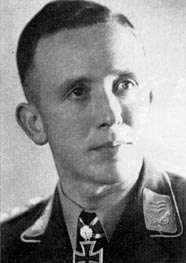Horst Ademeit
| Horst Ademeit | |
|---|---|
 Horst Ademeit | |
| Born |
8 February 1912 Breslau |
| Died |
7 August 1944 (aged 32) near Dünaburg |
| Allegiance |
|
| Service/branch |
|
| Years of service | 1936–44 |
| Rank | Major |
| Unit | JG 54 |
| Commands held | I./JG 54 |
| Battles/wars | |
| Awards | Knight's Cross of the Iron Cross with Oak Leaves |
Horst Ademeit (Adomaitis)[1] (8 February 1912 – 7 August 1944) was a Lithuanian descent German former Luftwaffe fighter ace and recipient of the Knight's Cross of the Iron Cross with Oak Leaves (German: Ritterkreuz des Eisernen Kreuzes mit Eichenlaub) during World War II. The Knight's Cross of the Iron Cross and its higher grade Oak Leaves was awarded to recognise extreme battlefield bravery or successful military leadership. A flying ace or fighter ace is a military aviator credited with shooting down five or more enemy aircraft during aerial combat.[2]
Early life
Ademeit, the son of a Regierungsbaurat (government building officer), was born on 8 February 1912 in Breslau in the Kingdom of Prussia of the German Empire, present-day Wrocław in western Poland. He studied at the Königsberg Albertina University, a member of the Corps Masovia Königsberg. He then studied chemistry at the Technical University of Berlin and the Technical University of Braunschweig graduating as Diplom Ingenieur. He joined the military service of the Luftwaffe on 1 August 1936.[3]
On 9 December 1938, Ademeit was made an officer cadet of the reserves and received flight training.[3]
World War II
In the spring of 1940, Unteroffizier Ademeit was transferred to 3./Jagdgeschwader 54 (JG 54—54th Fighter Wing) and participated in the Battle of Britain.[Note 1] He claimed his first victory on 18 September 1940 shortly afterwards he was shot down over the Channel. He bailed out and was rescued by the Seenotdienst unharmed.
In June 1941, after the attack on the Soviet Union, he accompanied I./JG 54 to the Eastern Front. In quick succession he achieved aerial victories, promotions and awards. On 15 January 1944, Ademeit was credited with his 100th aerial victory. He was the 61st Luftwaffe pilot to achieve the century mark.[4] In the beginning of August 1944, Ademeit was appointed acting Geschwaderkommodore (wing commander) of JG 54.
On 7 August 1944, Ademeit, flying a Focke Wulf Fw 190 A-5 (Werksnummer 5960 — factory number) pursued a Russian Il-2 Sturmovik ground-attack aircraft eastwards over Russian lines near Dünaburg, however he failed to return from this mission and is considered Missing in action since.[5]
Horst Ademeit was credited with 166 victories in over 600 missions. He recorded 164 of his victories over the Eastern Front. He was posthumously promoted to Major.[5]
Awards
- Iron Cross (1939)
- Front Flying Clasp of the Luftwaffe for fighter pilots in Gold and Penant
- Ehrenpokal der Luftwaffe on 8 December 1941 as Leutnant and pilot[5][7]
- German Cross in Gold on 25 February 1942 as Leutnant in the 1./JG 54[8]
- Knight's Cross of the Iron Cross with Oak Leaves
Notes
- ↑ For an explanation of the meaning of Luftwaffe unit designation see Luftwaffe Organization
References
Citations
- ↑ Turinys / Ginkluotosios pajėgos / Lietuviai Vermachte - Antrasis pasaulinis karas
- ↑ Spick 1996, pp. 3–4.
- 1 2 Stockert 2007, p. 29.
- ↑ Obermaier 1989, p. 243.
- 1 2 3 Obermaier 1989, p. 60.
- 1 2 Thomas 1997, p. 2.
- ↑ Patzwall 2008, p. 40.
- ↑ Patzwall & Scherzer 2001, p. 11.
- 1 2 Scherzer 2007, p. 188.
- ↑ Fellgiebel 2000, p. 113.
- ↑ Fellgiebel 2000, p. 79.
Bibliography
- Fellgiebel, Walther-Peer (2000) [1986]. Die Träger des Ritterkreuzes des Eisernen Kreuzes 1939–1945 — Die Inhaber der höchsten Auszeichnung des Zweiten Weltkrieges aller Wehrmachtteile [The Bearers of the Knight's Cross of the Iron Cross 1939–1945 — The Owners of the Highest Award of the Second World War of all Wehrmacht Branches] (in German). Friedberg, Germany: Podzun-Pallas. ISBN 978-3-7909-0284-6.
- Obermaier, Ernst (1989). Die Ritterkreuzträger der Luftwaffe Jagdflieger 1939 – 1945 [The Knight's Cross Bearers of the Luftwaffe Fighter Force 1939 – 1945] (in German). Mainz, Germany: Verlag Dieter Hoffmann. ISBN 978-3-87341-065-7.
- Patzwall, Klaus D.; Scherzer, Veit (2001). Das Deutsche Kreuz 1941 – 1945 Geschichte und Inhaber Band II [The German Cross 1941 – 1945 History and Recipients Volume 2] (in German). Norderstedt, Germany: Verlag Klaus D. Patzwall. ISBN 978-3-931533-45-8.
- Patzwall, Klaus D. (2008). Der Ehrenpokal für besondere Leistung im Luftkrieg [The Honor Goblet for Outstanding Achievement in the Air War] (in German). Norderstedt, Germany: Verlag Klaus D. Patzwall. ISBN 978-3-931533-08-3.
- Schaulen, Fritjof (2003). Eichenlaubträger 1940 – 1945 Zeitgeschichte in Farbe I Abraham – Huppertz [Oak Leaves Bearers 1940 – 1945 Contemporary History in Color I Abraham – Huppertz] (in German). Selent, Germany: Pour le Mérite. ISBN 978-3-932381-20-1.
- Scherzer, Veit (2007). Die Ritterkreuzträger 1939–1945 Die Inhaber des Ritterkreuzes des Eisernen Kreuzes 1939 von Heer, Luftwaffe, Kriegsmarine, Waffen-SS, Volkssturm sowie mit Deutschland verbündeter Streitkräfte nach den Unterlagen des Bundesarchives [The Knight's Cross Bearers 1939–1945 The Holders of the Knight's Cross of the Iron Cross 1939 by Army, Air Force, Navy, Waffen-SS, Volkssturm and Allied Forces with Germany According to the Documents of the Federal Archives] (in German). Jena, Germany: Scherzers Militaer-Verlag. ISBN 978-3-938845-17-2.
- Spick, Mike (1996). Luftwaffe Fighter Aces. New York: Ivy Books. ISBN 978-0-8041-1696-1.
- Stockert, Peter (2007). Die Eichenlaubträger 1939–1945 Band 5 [The Oak Leaves Bearers 1939–1945 Volume 5] (in German). Bad Friedrichshall, Germany: Friedrichshaller Rundblick. OCLC 76072662.
- Thomas, Franz (1997). Die Eichenlaubträger 1939–1945 Band 1: A–K [The Oak Leaves Bearers 1939–1945 Volume 1: A–K] (in German). Osnabrück, Germany: Biblio-Verlag. ISBN 978-3-7648-2299-6.
